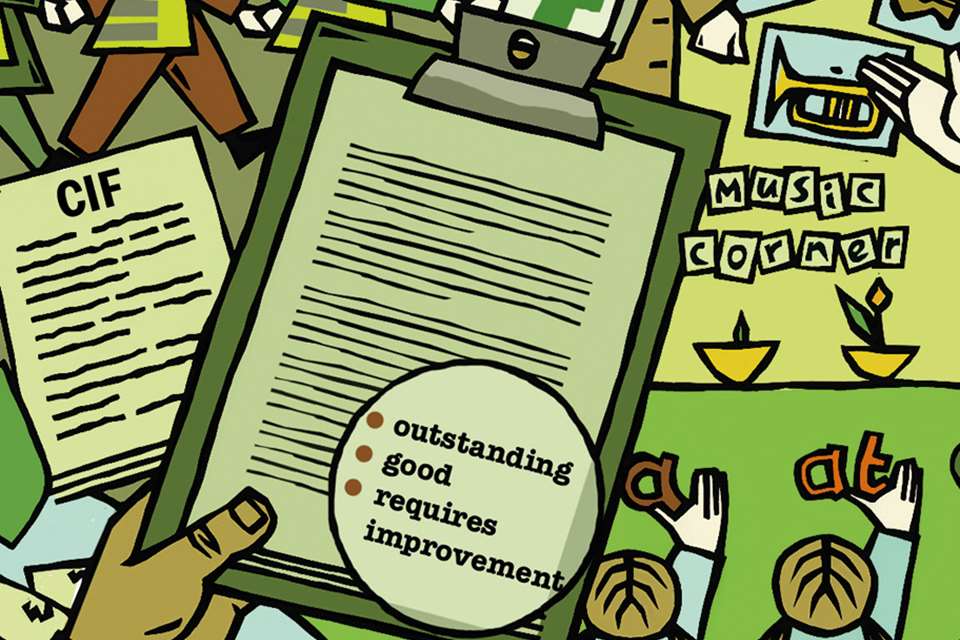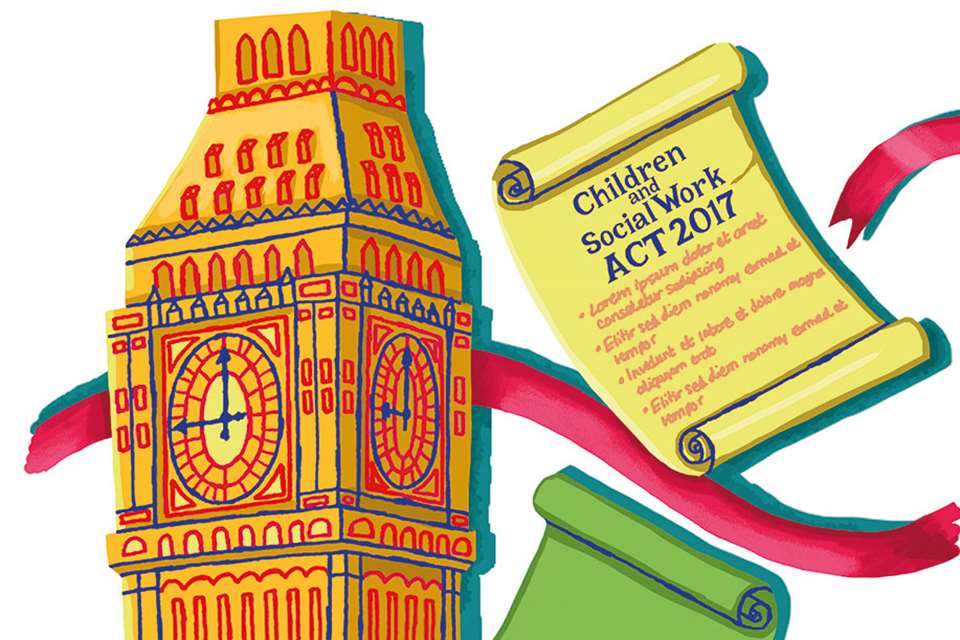Safeguarding - A complex web
Ann-Marie Christian and Hannah Crown
Monday, February 6, 2017
Safeguarding is not just a single agency issue, and the other professionals who get involved are facing complex pressures. What is the bigger picture, and how does it all fit together? Ann Marie Christian and Hannah Crown report

Early years staff engage with parents face to face when they’re in the setting dropping off and collecting their children. Some settings carry out home visits before children start. But are staff able to pick up on suspicions of abuse, controlling behaviour or neglect? Do they document their observations from their home visits? Would they raise a concern if the house had no toys or was too dirty? Children aged under five are not as vocal as older children in expressing worries. Serious case reviews, two-thirds of which concern children under five, highlight these issues time and time again.
Beyond the early years, there are a myriad of processes which professionals from agencies such as social care, health and police must follow. These services are under ‘complex and urgent’ pressure, as a December study by the Association of Directors of Children’s Services (ADCS) has found. The 2015/16 study looked at 132 councils across the UK and found that a fifth of all children on child protection plans are now aged under one. Domestic violence and neglect are common reasons for the involvement of social services, yet support is being cut.
EARLY HELP
Early help is a catch-all term for a range of interventions to help children and families resolve problems at an early stage. The ADCS survey indicates that these relatively new services are evolving (three-quarters of councils saying they had changed to a high or moderate degree in the past two years). But spending by local authorities on early help services for children and families has fallen by 31 per cent in real terms, the report found.
Despite this, there has been an 11 per cent increase in the number of early help assessments. A third of councils have some type of integrated early help model. Just nine of the 61 councils which provided information about this have the gold standard: co-located early help and social care services, known as Multi-agency Safeguarding Hubs (MASHs).
A single point of contact for information about a safeguarding concern, MASHs can be used where an early years practitioner has identified a child who might be at risk. They can contact the MASH before deciding whether or not to make a referral to the local authority, and will be advised on whether the child protection threshold has been met and if it has, to make a formal referral. ‘Referring’ in this way does not constitute a crime report or social services referral in itself.
In addition, every local authority has a Local Safeguarding Children Board (LSCB) that sets the local child protection procedures, thresholds and expectations. These should be reflected in a childcare setting’s policies. The LSCBs all have websites that clearly document their early help process/offer/model (titles vary across the country).
The Inspecting Safeguarding in Early Years guidance clearly states that every setting should have a designated safeguarding member (DSM) of staff who leads on child protection concerns and should be trained appropriately. The DSM should be familiar with their local safeguarding board’s procedures and referral pathways for both early help and child protection queries. If the threshold has not been met, the DSM would be expected to support the family with the early help offer.
Overall, the ADCS report found that referrals to social services are down 7 per cent, while initial contacts (requests for general advice or information made of children’s services) have gone up by 5 per cent.
BEYOND REFERRALS
Social services now make a ‘single assessment’ for every child referred to them that meets the appropriate threshold for intervention. The number of single assessments (which replace a system of ‘initial’ and ‘core’ assessments) has increased by 5 per cent, according to the report. Section 47 enquiries, undertaken for children about whom there are serious concerns of harm or suffering, have also increased by 5 per cent. The number of children on a Child Protection Plan (CPP) continues to increase; 54,279 children became subjects of these plans in 2015/6 – an increase of 3 per cent on 2013/14.
CPPs are the result of child protection referrals made to MASH/social care where thresholds have been met for children at risk of significant harm. The Initial Child Protection Conference takes place 10 to 15 days after the assessment is done, and early years designated members would be invited to attend. From this, a report is completed and shared with members of the conference and family. At the end of the conference, families are warned that if the plan does not progress or the child is put at further risk then the local authority may embark on legal proceedings.
The proportion of children on CPPs who are aged under one has also increased, from 16 to 18 per cent. The number of CPPs involving one- to four-year-olds is just over a quarter, having decreased from 30 per cent. The most common age group are five- to nine-year-olds (28 per cent of all CPPs).
THE ISSUES
The ‘toxic trio’ of domestic abuse, parental mental health issues and substance misuse continue to be a major, and increasing, reason for involvement of children’s social care. According to the ADCS report, ‘research undertaken in an eastern region authority concluded that the toxic trio was present in 90 per cent of cases’.
Half of all children in need have experienced or witnessed domestic violence, according to DfE data. The ADCS survey also found that, of all the potential factors contributing to a child being ‘in need’, domestic violence is the most common (27 per cent of all single assessments of these children carried out last year included concerns about the parent being subjected to domestic violence. More than one in ten – 11 per cent – included concerns about the child being subjected to domestic abuse). Despite this, some councils say they have been forced to cut their domestic abuse services.
Overall, child abuse and neglect are the subject of 53 per cent of all social care referrals. Neglect is the most common reason for a child to be on a CPP (45 per cent of initial plans are due to this), and emotional abuse now accounts for 35 per cent. Defined as consistently failing to meet the basic needs of the child, neglect is difficult to prove and staff have to be aware of how it presents, and recordings and chronologies are an important process in gaining evidence to capture this.
Over the past eight years, neglect and domestic violence have increased at an alarming rate. Emotional abuse (which includes domestic violence) has more than doubled, from a rate of 8 per 10,000 population to 19, and for neglect from 14 to 24 – or a rise of 75 per cent.
Fundamentally, early years practitioners should be empowered via their child protection training to know how and when to raise a concern. Staff should be familiar with their child protection policies and reminded regularly about them and the challenges when working in child protection. Staff with concerns should share with the DSM immediately and log them. They should follow the setting’s procedures and seek advice from the DSM before approaching the parent or carer. And key staff should sign up with child protection champions to get regular updates.
Ann Marie Christian is an independent safeguarding and child protection consultant, www.annmariechristian.com
GLOSSARY
Early help assessments are carried out by professionals who work with a child and their family, with parental consent. Where a child and family would benefit from co-ordinated multi-agency support (e.g. education, health, housing, police) there should be an inter-agency assessment. According to the Government’s 2015 ‘Working Together’ guidance, ‘These early help assessments, such as the Common Assessment Framework, should identify what help the child and family require to prevent needs escalating to a point where intervention would be needed via a statutory assessment under the Children Act 1989.’
Initial contacts - requests for general advice or information made of local authority children’s services. The case may, or may not be accepted as a referral
Referral - a request for services to be provided by local authority children’s social care services via the assessment process outlined in Working Together.
Child in need – someone who is unlikely to reach or maintain a satisfactory level of health or development, or whose health or development will be significantly impaired, without the provision of services.
Single assessment – this is not the early help assessment. It is carried out for every child for whom a referral has been accepted by a local authority’s social care services.
Section 47 enquiries – undertaken by local authorities where they have reasonable cause to suspect that a child is suffering, or is likely to suffer, significant harm, to enable them to decide whether they should take any action to safeguard and promote the child’s welfare.
FURTHER INFORMATION
NSPCC’s CASPAR service, https://www.nspcc.org.uk/services-and-resources/research-and-resources/sign-up-to-caspar
Case reviews, https://www.nspcc.org.uk/preventing-abuse/child-protection-system/case-reviews/2016
Inspection guidance, https://www.gov.uk/government/publications/inspecting-safeguarding-in-early-years-education-and-skills-from-september-2015
Statutory guidance, https://www.gov.uk/government/publications/working-together-to-safeguard-children--2
Association of Directors of Children’s Services report, http://bit.ly/2jK8DzS







